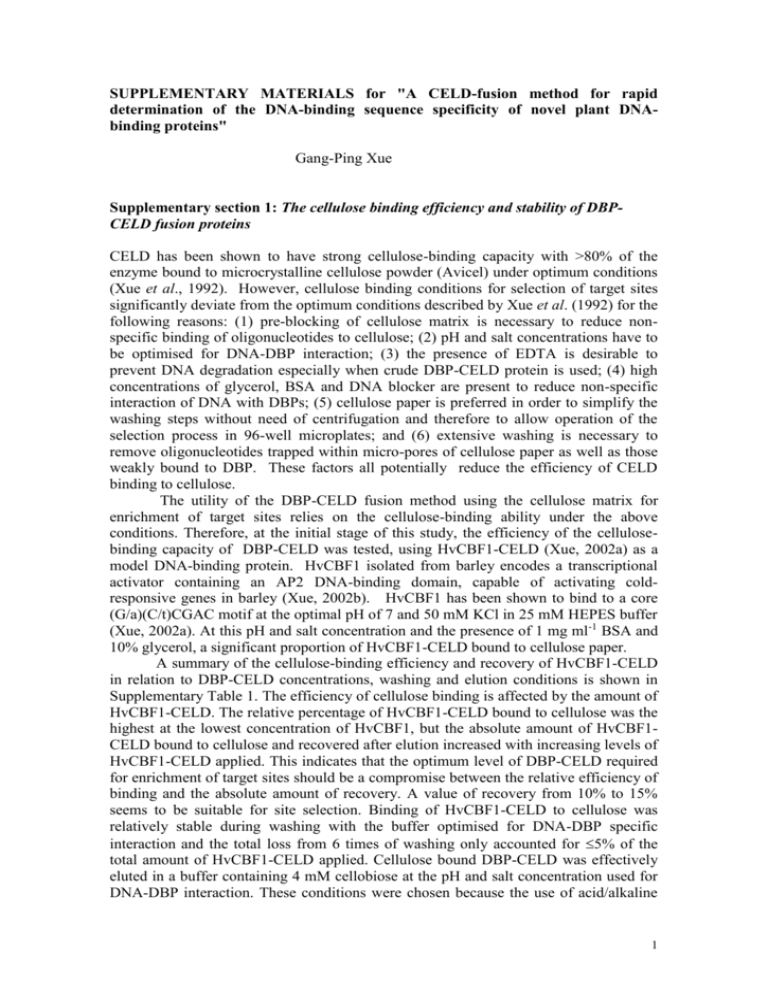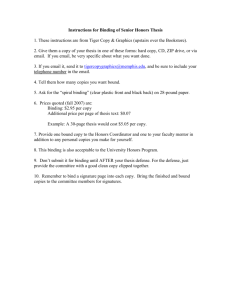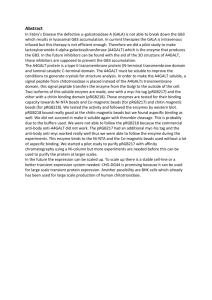A rapid non-radioactive method for quantitative analysis of DNA
advertisement

SUPPLEMENTARY MATERIALS for "A CELD-fusion method for rapid determination of the DNA-binding sequence specificity of novel plant DNAbinding proteins" Gang-Ping Xue Supplementary section 1: The cellulose binding efficiency and stability of DBPCELD fusion proteins CELD has been shown to have strong cellulose-binding capacity with >80% of the enzyme bound to microcrystalline cellulose powder (Avicel) under optimum conditions (Xue et al., 1992). However, cellulose binding conditions for selection of target sites significantly deviate from the optimum conditions described by Xue et al. (1992) for the following reasons: (1) pre-blocking of cellulose matrix is necessary to reduce nonspecific binding of oligonucleotides to cellulose; (2) pH and salt concentrations have to be optimised for DNA-DBP interaction; (3) the presence of EDTA is desirable to prevent DNA degradation especially when crude DBP-CELD protein is used; (4) high concentrations of glycerol, BSA and DNA blocker are present to reduce non-specific interaction of DNA with DBPs; (5) cellulose paper is preferred in order to simplify the washing steps without need of centrifugation and therefore to allow operation of the selection process in 96-well microplates; and (6) extensive washing is necessary to remove oligonucleotides trapped within micro-pores of cellulose paper as well as those weakly bound to DBP. These factors all potentially reduce the efficiency of CELD binding to cellulose. The utility of the DBP-CELD fusion method using the cellulose matrix for enrichment of target sites relies on the cellulose-binding ability under the above conditions. Therefore, at the initial stage of this study, the efficiency of the cellulosebinding capacity of DBP-CELD was tested, using HvCBF1-CELD (Xue, 2002a) as a model DNA-binding protein. HvCBF1 isolated from barley encodes a transcriptional activator containing an AP2 DNA-binding domain, capable of activating coldresponsive genes in barley (Xue, 2002b). HvCBF1 has been shown to bind to a core (G/a)(C/t)CGAC motif at the optimal pH of 7 and 50 mM KCl in 25 mM HEPES buffer (Xue, 2002a). At this pH and salt concentration and the presence of 1 mg ml-1 BSA and 10% glycerol, a significant proportion of HvCBF1-CELD bound to cellulose paper. A summary of the cellulose-binding efficiency and recovery of HvCBF1-CELD in relation to DBP-CELD concentrations, washing and elution conditions is shown in Supplementary Table 1. The efficiency of cellulose binding is affected by the amount of HvCBF1-CELD. The relative percentage of HvCBF1-CELD bound to cellulose was the highest at the lowest concentration of HvCBF1, but the absolute amount of HvCBF1CELD bound to cellulose and recovered after elution increased with increasing levels of HvCBF1-CELD applied. This indicates that the optimum level of DBP-CELD required for enrichment of target sites should be a compromise between the relative efficiency of binding and the absolute amount of recovery. A value of recovery from 10% to 15% seems to be suitable for site selection. Binding of HvCBF1-CELD to cellulose was relatively stable during washing with the buffer optimised for DNA-DBP specific interaction and the total loss from 6 times of washing only accounted for 5% of the total amount of HvCBF1-CELD applied. Cellulose bound DBP-CELD was effectively eluted in a buffer containing 4 mM cellobiose at the pH and salt concentration used for DNA-DBP interaction. These conditions were chosen because the use of acid/alkaline 1 pH or high salt concentration could potentially elute residual non-target oligonucleotides, which were non-specifically attached to cellulose paper. The efficiency of elution is significantly higher at 40oC than at room temperature (20-22oC). These data indicate that cellulose paper can be used for capturing DBP-CELD at the conditions used for many of DNA-DBP interaction. Supplementary Table 1. The efficiencies and stability of cellulose-binding and recovery of HvCBF1-CELD HvCBF1-CELD Elution temperature o 40 C 40oC 40oC RT Total protein (g)a Unbound before washing (%)b Total loss during washing (%)c Total bound HvCBF1-CELD (%)d Eluted (%) 1.9 54.2 3.4 42.4 (18.6) 5.8 73.1 5.0 21.9 (13.7) 17.4 80.5 4.2 15.3 (9.3) 5.8 71.6 4.8 23.6 (5.7) CELD activity of HvCBF1-CELD was 8960959 fluorescent units h-1 mg crude protein-1 in the cell lysate. Values are means of duplicate assays. a Total protein of crude HvCBF1-CELD preparation used for cellulose binding assay. b HvCBF1-CELD remained unbound after incubation with cellulose paper for 1 h in ice. c Total HvCBF1-CELD loss during washing 6 times. d Total bound HvCBF1-CELD is the sum of eluted and remaining bound to cellulose. Supplementary section 2: Determination of the suitability of random sequence oligonucleotides for selection of target binding sites The suitability of random sequence oligonucleotides, Bio-RS-Oligo 1-3 shown in Fig. 1b, for selection of target binding sites were pre-assessed using one member from each of the four plant transcription factor superfamilies. Data are summarised in Supplementary Table 2. Supplementary Table 2. The relative binding activity of DBPs to random sequence oligonucleotides (Bio-RS-Oligo 1-3) DBP-CELD Relative binding activity (ratio of Bio-RS-Oligo to SP-A) Bio-RS-Oligo 1 Bio-RS-Oligo 2 Bio-RS-Oligo 3 HvCBF1 OsbHLH66 TaMYB80 TaNAC69 1.23 1.32 1.63 0.98 1.08 4.13 2.24 1.24 1.43 2.19 3.26 0.95 Relative DNA-binding activity of DBP is expressed as the ratio of biotin-labelled BioRS-Oligo to biotin-labelled SP-A (control). Values are means of duplicate assays. Eight pmol of each probe was used per assay. 2 Supplementary Section 3: Evaluation of the binding efficiency and stability of DBPCelD6xHis on Ni-NTA magnetic beads Ni-NTA magnetic beads are a common matrix for purification of 6His-tagged proteins. The efficiency of the binding capacity of 6His-tagged DBP-CELD proteins and their stability under the conditions for target site selection were examined using two CELDfused DBPs, OsbHLH66 and TaNAC2. The expression level of OsbHLH66-CELD in E. coli was average, based on the cellulase activity, among 9 DBP-CELD genes examined, while the expression level of the TaNAC2-CELD construct was very low. The specific activity of the TaNAC2 construct was 12 times lower than that of the OsbHLH66 construct (Supplementary Table 3). A summary of the binding efficiency of OsbHLH66-CELD and TaNAC2-CELD to Ni-NTA beads in relation to DBP-CELD concentrations and their stability under the site selection conditions is shown in Supplementary Table 3. The optimal conditions for the binding of 6His-tagged proteins, suggested by the manufacturer, was used for this study. The efficiency of binding was affected by the amount of DBP-CELD and was generally higher than that of the CELD interaction with cellulose. The relative percentage of DBP-CELD bound to the Ni-NTA beads is the highest at the lowest concentration of OsbHLH66-CELD, but the amount of OsbHLH66-CELD bound to the beads increased with increasing levels of the DBP-CELD. For a lower expression level of the DBP-CELD construct, TaNAC2-CELD, the amount of bound protein increased linearly with increasing amounts of the protein. The bound protein was stable under the conditions used for target site binding and a subsequent washing step. Some loss of the CELD activity was partially due to the loss of some beads during the washing process. Based on these results, I used about 10 g crude protein for the DBP-CELD constructs with a moderate expression level and 25 g for a low expression construct for target site selection. The use of a lower amount of a DBP would potentially reduce the efficiency of binding site enrichment, as it would decrease the ratio of target oligonucleotides to non-target oligonucleotides, which non-specifically bind to or are trapped in the matrix. Supplementary Table 3. The efficiency and stability of 6His-tagged DBP-CELD binding to Ni-NTA magnetic beads under the conditions used for binding site selection DBP-CELD (g crude protein) The CELD activity of DBP-CELD OsbHLH66 TaNAC2 Total Act % bound % remained Total Act % bound % remained (FU h-1) to beadsa at last stepb (FU h-1) to beadsa at last stepb 3.3 10 20 40 51427 154282 308564 617128 96.7 69.1 40.3 21.3 76.1 54.5 31.0 16.9 4279 12837 25674 51348 98.1 98.4 94.7 92.6 76.4 77.8 75.1 73.4 Values are means of duplicate assays. Act, CELD activity; FU, fluorescent unit. a DBP-CELD bound to washed Ni-NTA magnetic beads after incubation for 1 h for binding of DBP-CELD to the beads. b DBP-CELD remained bound to Ni-NTA magnetic beads after incubation of DBPCELD bound beads with Bio-RS-Oligo and washed 4 times for removal of unbound oligonucleotides. 3 Supplementary Section 4: Evaluation of the stability of DNA-DBP complex during the washing steps of the target binding-site selection To evaluate whether extensive washing can be used for enrichment of binding sites, the relative stability of the DNA-DBP complex was tested using a biotinylated HvCBF1 target site, HVA1E1 (Xue, 2002a), immobilised on a streptavidin-coated microplate. This assumes that the DNA-DBP complex immobilised on a streptavidin plate is physically similar to that of the DNA-DBP complex immobilised on cellulose paper or Ni-NTA beads used in the site selection described in this study. The relative cellulase activity of HvCBF1-CELD remaining bound to biotinylated HVA1E1 after washed 8 times (4 min for each washing) was 85% of that after washed 3 times (2 min for each washing), which was used in a standard DNA-binding assay (Xue, 2002a). This indicates that an extensive washing regime can be used to maximise the selection of target sites, based on the assumption that the selected sites by most DBPs possess moderate or high binding affinity. 4








